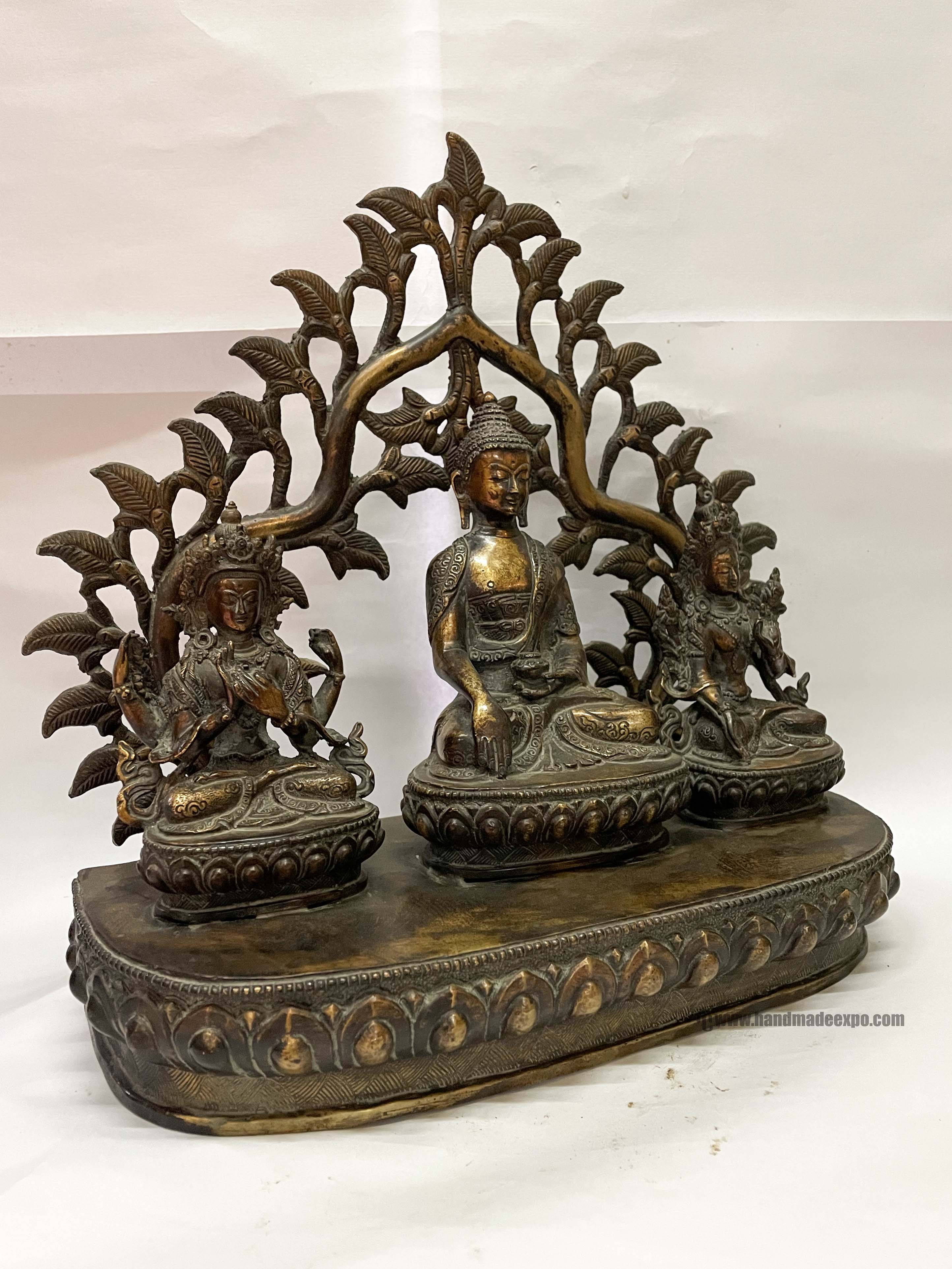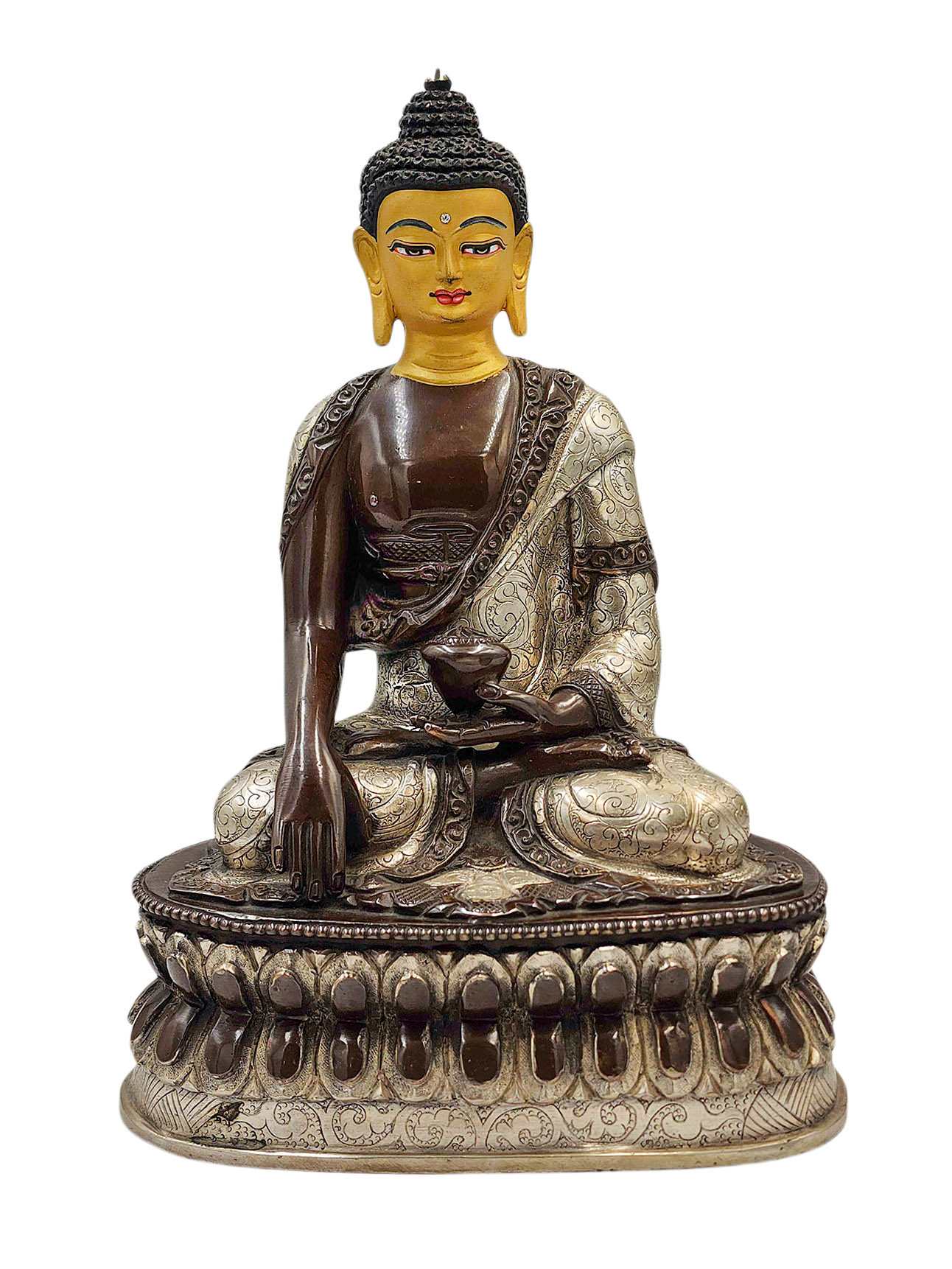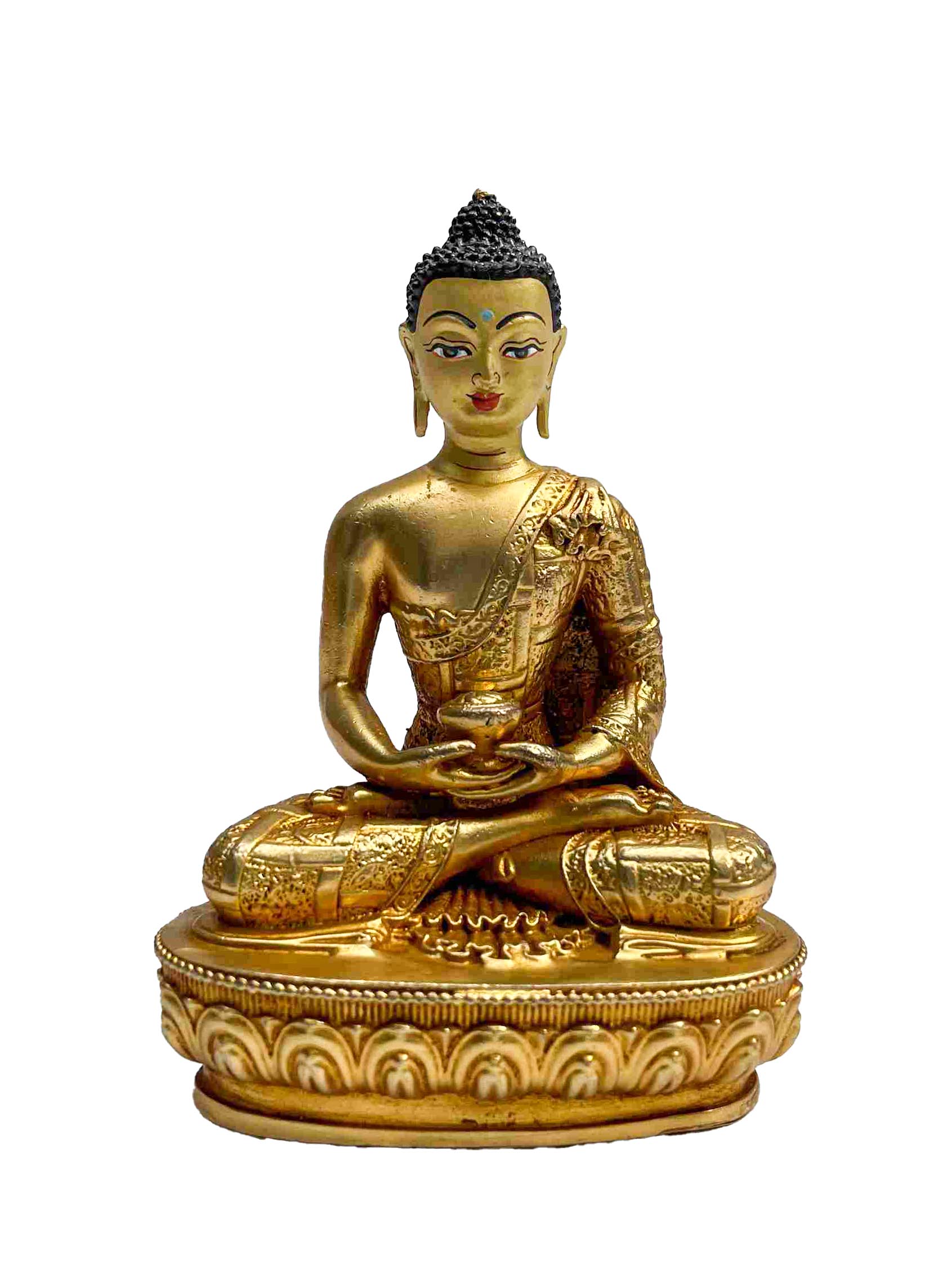

Safe Payment
We accept Paypal, Money Transfer, Bank Transfer
Confidence
Protection covers your purchase and personal data.
Worldwide Delivery
We ship Worldwide, except Russia.Shipping cost US$25.2 for upto 0.5 kgs

Hotline
Talk to help line for your question on 9841267335Buddha Aparimita is very popular in bestowing long life upon the devotees. It is red in color. His two hands are in dhyana mudra and holds an ambrosia vase. He usually wears all the ornaments of different kinds peculiar to a Sambhogakaya Buddha. He is never depicted with any consort. He wears a crown and has Ushnisha and Urnakosh on his body. Read More . . .
White Tara is a revered figure in Buddhist mythology, often depicted as a compassionate and serene goddess. She embodies peace and emanates loving compassion, bringing grace and dignity to various situations. White Tara's presence encourages the emergence of goodness and positive outcomes in all circumstances. She upholds the Four Measureless States, which include Loving Kindness, Compassion, Sympathetic Joy, and Equanimity, encompassing past, present, and future circumstances. Additionally, White Tara is associated with the bestowing of longevity, symbolizing a long and healthy life. Her essence embodies the ideals of compassion and benevolence, making her a significant figure in Buddhist worship and spiritual practices. Read More . . .
Samaya Tara, popularly known as Green Tara. She is represented in a royal ease posture with her left leg bent her left leg overstepping the main lotus and resting on a blue lotus ready to get up and offer assistance to those in need. She is portrayed with maroon Buddhist robes and jewelry. The earrings represent patience, understanding, and renunciation. The diadem with five jewels represents the transmutation of the five delusions into the Five Buddha Wisdoms. She is shown with a benevolent countenance seated upon a white moon disk which is associated with special restorative nectar associated with the naval chakra center. In Buddhists, the moon symbolizes the wisdom aspect which when coupled with compassion leads to Sakyamuni Buddha's enlightenment. Her right hand is gracefully lowered in Varada mudra, the boon-granting gesture. Read More . . .
Manjushree is a Sanskrit word meaning 'gentle glory'. In Sanskrit, "shree" means 'glorious' or 'honorable'. His name signifies one who embodies enlightened wisdom. He confers mastery of the Dharma, wisdom, and eloquence and teaches the path of a bodhisattva in the Mahayana tradition. Read More . . .
Vajrasattva is also regarded as Adi-Buddha by Nepalese Bajracharya's who follow Vajrayana tradition according to the text Vajrasattva Kaya. His body is white with one face and two hands. His right-hand holds a five-pronged golden vajra at his heart. His left-hand holds a silver bell at his side. He sits in the Vajraparyanka posture wearing precious silks and ornaments with jewel diadem. His body is adorned with the major and minor marks of a Sambhogakaya and emits a clear limitless light. It appears to lack all notion of substantiality, like the reflection of the moon in the water.
Vajrasattva has a father-mother aspect too. Generally, this form is not exhibited in open. It is shown only to those who are initiated in the Highest Yoga Tantra. His form is the same as in the single one but his consort carries a Kartika in her right hand and a kapala in her left hand. Read More . . .
Shakyamuni Buddha appeared in this world with the sole purpose of benefitting all sentient beings. Out of great compassion Lord Buddha revealed many different means/paths to enlightenment and set forth three Wheels of Law to suit varying degrees of intelligence and receptivities.
Shakyamuni Buddha himself was, it is said, in the form of Vajradhara while he was teaching tantric path to his gifted disciples.
Vajradhara is depicted holding a Vajra and a bell in his left hand and his arms are kept crossed in front of him expressing complete integration of Prajna and Upaya. He is usually depicted in blue colour in vajraparyanka posture. He has a crown, an Urna and an Ushnisha as a Sambhogakaya Buddha. Vajradhara is also depicted in father-mother (Anju-Aji in Newari) aspect. en he holds his usual symbols while his arms are crossed at the back of his consort. the consort is none other than Prajnaparamita in deified form.
The Kargyudpa lineage of Tibetan Buddhism begins with the Buddha Vajradhara. The individual in this tradition is allowed to visualize his root Guru as Buddha Vajradhara. Guru Tilopa is said to have received Mahamudra instruction directly from Buddha Vajradhara through visions and other extraordinary means.
In Nispannayogavali, Vajradhara is the main deity in Vajrasattvamandala. He is three faced, six-armed and reddish white in color. His right arm holds a vajra, a sword and a kapala and his left hand holds a bell, an ankush and a noose. He stands in the Ardhaparyanka posture and dances in Tandava style. Read More . . .
Compassion for others had always been regarded as a virtue in early Buddhism, but it had a somewhat subordinate place to wisdom. In Mahayana Buddhism, compassion received an equal emphasis with wisdom, perhaps because the Mahayana was more consciously universal and covered a wider sector of society. In this view of the world, all men and women, not just those leading a monastic life, could achieve nirvana.
The four arms and hands signify the four immeasurable:
Immeasurable loving kindness
Immeasurable compassion
Immeasurable joy
Immeasurable equanimity.
Chenrezig, the Bodhisattva of Boundless Compassion, is the very embodiment and realization of the four immeasurable. The four immeasurable are the vehicles through which Chenrezig benefits beings.
The first two, the inner arms, have palms joined at the heart, holding a sky-blue, and wish fulfilling jewel. This symbolizes that in whatever way Chenrezig manifests to benefit beings, the quality of Chenrezig's mind is never separate from the all-pervasive primal wisdom.
In the outer right hand, Chenrezig is holding crystal beads and moving them the way we use a mala to count mantras. This symbolizes that there is not one moment when Chenrezig does not benefit beings. Like the steady movement of counting the beads, Chenrezig is continuously benefiting sentient beings and turning the wheel of enlightened activity.
In the outer left hand, Chenrezig holds a lotus flower. This symbolizes that in benefiting sentient beings, Chenrezig manifests in whatever forms are necessary in accordance with the mental capacities, circumstances, and aptitudes of sentient beings. Chenrezig may appear in any of the different realms, such as the hell realm or the hungry ghost realm. However Chenrezig may appear, he remains free from any of the worldly stains of the various realms of life, the way a lotus flower growing in a swamp appears free of the stain of the mud. The left hand of Chenrezig, holding the flower, symbolizes that stainlessness.
All the various features of this image have meaningful connections to the wonderful qualities of Chenrezig, and by focusing on these details as we visualize the image in the meditation, we can gradually awaken our own awareness of those same qualities in ourselves.
Kalu Rinpoche said, "One does not think of the deity's body as solid or material, made of flesh and blood like one's ordinary body, or made of metal or stone like an idol. One thinks of it as appearance that is inseparable from emptiness, like a rainbow or like a reflection in a mirror."
The particular wonderful qualities that Chenrezig manifests for us are just the ones we need to get more in touch with, as aspects of our own nature, if we want to become an enlightened Buddha, or even if we just want to become a truly compassionate person. We and the image of Chenrezig are two extremes we have flesh and blood bodies, but not as much compassion as we would like to have, and Chenrezig has a body made of rainbows, and boundless impartial compassion. When we put those two extremes together, in the Chenrezig meditation, we move in the direction of manifesting as a being with a physical body, a body of rainbow light and unlimited compassion.
Various aspects of the form we visualize remind us of the most important qualities of this particular manifestation of awakened mind, the qualities we are trying to connect to.
In visualization practice we imagine ourselves to be a Buddha, in this case the Buddha of Compassion, Avalokiteshvara. By replacing the thought of yourself as you, with the thought of yourself as Avalokiteshvara, you gradually reduce and eventually remove the fixation on your personal self, which expands your loving kindness and compassion, toward yourself and toward others, and your intelligence and wisdom becomes enhanced, allowing you to see clearly what someone really needs and to communicate with them clearly and accurately.
Avalokiteshvara, Chenrezig is the embodiment of that unselfish urge to look upon each other as loving equals. If you are in need of guidance in healing, unity, unselfishness, or the mastering of fears, you may meditate on the qualities of Avalokiteshvara, Chenrezig {as above}, say the mantra" Om Mani Padme Hum".
In most religious traditions one prays to the deities of the tradition in the hopes of receiving their blessing, which will benefit one in some way. In the Vajrayana Buddhist tradition the blessing and the power and the superlative qualities of the enlightened beings are not considered as coming from an outside source, but are believed to be inborn, to be aspects of our own true nature. Avalokiteshvara, Chenrezig, and his love and compassion are within us.
His Holiness The Dalai Lama said, "Thus the six syllables, "Om Mani Padme Hum", mean that in dependence on the practice which is in indivisible union of method and wisdom, you can transform your impure body, speech and mind into the pure body, speech, and mind of a Buddha."
Saddharma Puṇḍarīka Sūtra (Lotus Sūtra)
Kāraṇḍavyūha Sūtra
Prajanaparmita Hṛdaya Sūtra (Heart Sūtra)
Mahākaruṇā Dhāranī Sūtra (Nīlakaṇṭha Dhāraṇī)
Avalokitesvara Ekādaśamukha Dhāraṇī Sūtra
Cundī Dhāraṇī Sūtra
The Lotus Sūtra is generally accepted to be the earliest literature teaching about the doctrines of Avalokiteśvara. The Universal Gateway of Avalokitasvara Bodhisattva This chapter is devoted to Avalokitasvara, describing him as a compassionate bodhisattva who hears the cries of sentient beings, and who works tirelessly to help those who call upon his name. A total of 33 different manifestations of Avalokitasvara are described, including female manifestations, all to suit the minds of various beings. The chapter consists of both a prose and a verse section. This earliest source often circulates separately as its own sūtra, called the Avalokitasvara Sūtra and is commonly recited or chanted at Buddhist temples in East Asia.
In the Tibetan tradition, Avalokiteśvara is seen as arising from two sources. One is the relative source, where in a previous eon (kalpa) a devoted, compassionate Buddhist monk became a bodhisattva, transformed in the present kalpa into Avalokiteśvara. That is not in conflict, however, with the ultimate source, which is Avalokiteśvara as the universal manifestation of compassion. The bodhisattva is viewed as the anthropomorphised vehicle for the actual deity, serving to bring about a better understanding of Avalokiteśvara to humankind.
Seven forms of Avalokiteśvara in Tibetan Buddhism:
Amoghapāśa: not empty (or unerring) net, or lasso.
Vara-sahasrabhuja-locana / Sahasrabhujasahasranetra: 1000-hand and 1000-eye,
Hayagriva: with the head of a horse
Ekadasamukha: with 11 faces
Cund
Cintamani-cakra: wheel of sovereign power
Arya Lokiteśvara: the Holy sovereign beholder of the world (loka), a translation of īśvara, means "ruler" or "sovereign", holy one.
Modern scholarship
Western scholars have not reached a consensus on the origin of the reverence for Avalokiteśvara. Some have suggested that Avalokiteśvara, along with many other supernatural beings in Buddhism, was a borrowing or absorption by Mahayana Buddhism of one or more Hindu deities, in particular Shiva or Vishnu (though the reason for this suggestion is because the current name of the bodhisattva not the original one.)
The Japanese scholar Shu Hikosaka on the basis of his study of Buddhist scriptures, ancient Tamil literary sources, as well as field survey, proposes the hypothesis that, the ancient mount Potalaka, the residence of Avalokiteśvara described in the Gandavyuha Sutra and Xuanzang's Records, is the real mountain Potikai or Potiyil situated at Ambasamudram in Tirunelveli district, Tamil Nadu. Shu also says that mount Potiyil/Potalaka has been a sacred place for the people of South India from time immemorial. With the spread of Buddhism in the region beginning at the time of the great king Aśoka in the third century B.C.E., it became a holy place also for Buddhists who gradually became dominant as a number of their hermits settled there. The local people, though, mainly remained followers of the Hindu religion. The mixed Hindu-Buddhist cult culminated in the formation of the figure of Avalokiteśvara
In Theravada, Lokeśvara, "the lord, ruler or sovereign beholder of the world", name of a Buddha; probably a development of the idea of Brahmā, Vishnu or Śiva as lokanātha, "lord of worlds". In Indo-China especially it refers to Avalokiteśvara, whose image or face, in masculine form, is frequently seen, e.g., at Angkor. The name Lokeśvara should not be confused with that of Lokesvararaja, the Buddha under whom Dharmakara became a monk and made forty-eight vows before becoming Amitabha Buddha.



 of 21 Tara Set
of 21 Tara Set  of 21 Tara Set
of 21 Tara Set  of Shakyamuni Buddha, Amitabha Buddha
of Shakyamuni Buddha, Amitabha Buddha  of Shakyamuni Buddha, Amitabha Buddha
of Shakyamuni Buddha, Amitabha Buddha  of Buddhist Statue
of Buddhist Statue  of Buddhist Statue
of Buddhist Statue  and Gold Plated Edition" title="5 Essential Buddhist Pancha Buddha Set, Copper
and Gold Plated Edition" title="5 Essential Buddhist Pancha Buddha Set, Copper  Shakyamuni Buddha, Medicine Buddha
Shakyamuni Buddha, Medicine Buddha  Shakyamuni Buddha, Medicine Buddha
Shakyamuni Buddha, Medicine Buddha  Dorje Drolo Set, Buddhist Handmade Statue,
Dorje Drolo Set, Buddhist Handmade Statue,  Dorje Drolo Set, Buddhist Handmade Statue,
Dorje Drolo Set, Buddhist Handmade Statue,  of Pancha Buddha Set
of Pancha Buddha Set  of Pancha Buddha Set
of Pancha Buddha Set  of Three Buddha Set,
of Three Buddha Set,  of Three Buddha Set,
of Three Buddha Set,  of Chatur Maharaj, Full Fire Gold Plated,
of Chatur Maharaj, Full Fire Gold Plated,  of Chatur Maharaj, Full Fire Gold Plated,
of Chatur Maharaj, Full Fire Gold Plated,  Sakyapa Set, Buddhist Handmade Statue,
Sakyapa Set, Buddhist Handmade Statue,  Sakyapa Set, Buddhist Handmade Statue,
Sakyapa Set, Buddhist Handmade Statue,